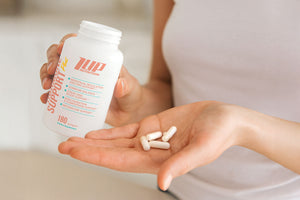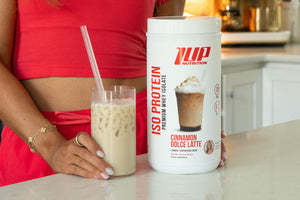No doubt you’ve heard the age-old axiom: “breakfast is the most important meal of the day.”
And, there is much truth to that.
What you eat for breakfast can work for (or against) your weight loss transformation results.
In fact, a recent study found that individuals who ate a heartier breakfast compared to a bigger dinner ended up burning more calories during the day.[1]
But, that’s not all, researchers also found that individuals who ate larger breakfasts compared to dinner experienced fewer hunger pangs and less cravings for sweets during the day.[1]
To ensure you’re getting the greatest benefits from your breakfast, here are 10 breakfast rules for weight loss.
Top 10 Breakfast Rules for Weight Loss
#1 Prioritize Protein
Consuming enough protein is essential for muscle repair and growth. It also plays a fairly prominent role in weight loss, yet many individuals opt for breakfasts woefully deficient in protein (e.g. bagel or doughnut and coffee).
Protein is the most satiating macronutrient, which means it helps keep you feeling fuller for longer, making it less likely you’ll overeat during a meal or snack in between meals. Protein also increases levels of satiety hormones like GLP-1, peptide YY and cholecystokinin, while also reducing levels of the hunger hormone, ghrelin.[2,3,4,5]
Additional studies find that individuals who consume high protein breakfasts tend to have better diet quality and reduced food motivation and reward.[6]
Not only does protein help fill you up, it also helps your body burn more calories during the day. The reason for this is that protein has a higher thermic effect than either carbohydrates or fat, which means your body has to use more energy (calories) to digest protein than other macronutrients.
Essentially, protein helps weight loss from multiple fronts -- it keeps you feeling full, ramps up calorie burning, and helps build muscle, and the more muscle you have the higher your resting metabolic rate it is!
As we mentioned before, many individuals struggle to consume enough protein at breakfast. One of the easiest ways to amp up your breakfast with protein is by mixing in a scoop of protein powder, such as 1UP Whey Protein or 1UP Organic Vegan Protein, and have it alongside your normal breakfast fare.
Protein is a macronutrient that is essential for recovery and muscle building. Protein Shake is a very convenient and a fast way to get your protein in. Drink it immediately post workout to start the recovery process. Also helps with sweet cravings while dieting
You could also make a protein-packed smoothie filled with fruit, milk, and nut butter, or a hot, satisfying bowl of proatmeal! The options for ways to incorporate protein are endless, just make sure that you get in a quality serving of it at breakfast!
#2 Go Savory Instead of Sweet
Far too often, breakfast consists of a bowl of sugary cereal, or a mound of pancakes smothered in syrup.
Aside from satisfying a sweet tooth, these breakfasts do little to optimize weight loss or fill you up.
They do take a massive chunk of calories from your daily calorie intake all the while skyrocketing your blood sugar and insulin levels, which invariably means both will come crashing down just a little while later. This will leave you feeling tired, sluggish, and, worst of all, hungry.
Sweet breakfasts also make it more likely you’ll crave sweet foods the rest of the day.
Instead of starting your day on a sugar-high, opt for a savory breakfast (bacon and eggs, omelette, etc.). You’ll avoid the roller coaster blood sugar ride and get a powerful hit of protein (see above why that’s so important for weight loss!).
#3 Include High Volume Foods
High-volume foods are foods that take up a lot of space, but contain relatively low amounts of calories. As you probably guessed, this means fruits and veggies.
Fruits and vegetables are nutritional powerhouses, teeming with vitamins, minerals, antioxidants, and fiber.
Essentially, these foods help to take up space in your stomach and slow the digestion process, which helps prevent overeating and keeps you on track with your weight loss goals.
A few of our favorite high-volume breakfast foods include:
- Strawberries
- Blueberries
- Spinach
- Tomatoes
- Cantaloupe
- Honeydew melon
- Bell peppers
If you’re looking to further amp up the volume on your fruit and veggie intake at breakfast, you can also mix up a serving of 1UP Organic Vegan Greens & Reds Superfoods, which contains 19 organic fruits and vegetables in every scoop along with 3 grams of fiber! If you are like most people and hate eating vegetables every day, then this product is perfect for you.
#4 Avoid Empty Carbs
As we mentioned at the outset, breakfast for many individuals consists of nothing but coffee and some type of simple carb -- doughnut, bagel, toast, etc.
Carbohydrates are an important source of energy for the body (especially your muscles), but having them sans protein or fat, means they’re rapidly digested, thereby doing little to keep you feeling full for long.
If you do want to go the coffee and carb route in the morning, make sure to find some way to sneak in some protein, fat, and fiber.
A simple way to do this is to add a schmear of low-fat cream cheese to your bagel or a tablespoon of nut butter to your toast. And, to your coffee, you can add a scoop of whey protein powder. Our personal favorite is 1UP Caramel Macchiato whey protein.
This allows you to have your carbs while satisfying all the essentials needed for a proper weight loss breakfast!
#5 Plan Your Breakfast
Mornings are a time when most of us are in a frenzy trying to get things packed and prepped for the day. This haste inevitably leads us to make poor breakfast choices (bagel and coffee) or eat no breakfast at all.
And, while we realize not everyone reading this has the time (or desire) to whip up a gourmet breakfast, with just a bit of planning and prep you can have a delicious, high-protein breakfast ready in a pinch.
It all starts with deciding the day or night before what you’re going to have for breakfast. Now, it doesn’t have to be anything fancy (though it can be, certainly), but it should be something substantial that will tide you over for a few hours.
Ideal options that can be prepped ahead and ready to grab and go in the morning are overnight oats, hard boiled eggs, or baked egg cups. If you’re really pressed for time, and forgot to prep something the night before, you can whip up a quick protein smoothie with milk, protein powder, nut butter and fruit, or grab a couple of our best-tasting 1UP Protein bars, which contain an impressive 18-20 grams of belly-filling protein per bar. Protein Bars are specially perfect for when you are running low on time.
#6 Eat Slowly
As part of our busy lifestyles, it’s become commonplace to whoof down our meals as quickly as possible so that we can get on with the rest of the day and all the tasks vying for our attention.
However, shoveling down your food is undercutting your weight loss efforts.
Eating too fast doesn’t give your brain enough time to receive the signal from your stomach that you’ve had enough to eat. This inevitably leads you to eating more than you need, and exceeding your calorie goals for the day.
We understand that life is busy, but try slowing down and savoring each bite. This simple act of mindfulness can pay huge dividends towards helping you not overeat and stay on track with your nutrition plan.
#7 Put Your Breakfast on a Plate
Building off of the last point, one of the ways to force yourself to slow down and eat more slowly is to put your breakfast on a plate.
Doing so will mean that you’ll in all likelihood have to use and knife and fork to eat your food. Juxtapose that with a fast-food breakfast sandwich that you hold in your hand while driving. Having something in your hard while driving likely means you’ll be trying to get it down as quickly as possible so that you can give your full attention to driving or working.
Plating up your breakfast helps you to focus on what’s in front of you (your food). The less distracted you are while eating, the less likely you are to overeat. Doing this may help you to feel fuller sooner and more satiated.
As an added bonus, plating up your breakfast can also help serve as a measure of portion control since you can see exactly how much food you’re putting on your plate.
#8 Limit Liquid Calories at Breakfast
Fruit smoothies, juices, and gourmet coffees are breakfast staples for many people. These beverages are high in calories but do little to actually fill you up or set you up for success the rest of the day.
The reason for this is that these beverages are high in sugar and low in protein and fiber.
As such, they should be limited, especially if you’re trying to lose weight.
Now, this isn’t to say all liquid calories are bad, you just need to choose the right ones.
For example, a protein smoothie is a great choice for breakfast as it is high in protein, fiber, and essential micronutrients, and it can be customized to whatever your palate desires.
Here’s a simple base for a dynamite breakfast smoothie:
- 1 cup milk
- 1 scoop protein powder (1UP Whey Protein or Organic Vegan Protein)
- 1 serving frozen berries
- ½ frozen banana
- 1 tablespoon nut butter (or 1 serving of flax seeds or chia seeds)
- Frozen spinach (to taste)
- ½-1 cup ice cubes
Blend it all together and you have the perfect weight loss breakfast shake!
#9 Watch for Trends
This rule is mostly in regards to how you’re feeling the rest of the day after breakfast.
Take stock of your energy levels, hunger levels, cravings, etc.
For instance, if you find that on days you have oatmeal morning you spend the rest of the day with an intense cravings for sweets, you might want to think of starting the day with a different breakfast.
However, let’s say you had breakfast tacos on another day and felt very satisfied all the way until lunch.
Being cognizant of the ways in which different breakfasts affect your productivity, hunger, and satiety levels can go a long way towards helping you make the best breakfast choices for weight loss.
#10 Try Something Different
Just because you’re eating breakfast doesn’t mean that you have to go for typical breakfast fare like pancakes, waffles, oatmeal, or even scrambled eggs.
Breakfast is simply the first meal of the day in which you break your overnight fast.
As such, breakfast could be chicken or steak fajitas, spinach salad with grilled chicken or salmon, or a delicious yogurt-based dip with all sorts of veggies and whole grain bread for dipping.
Starting the day with a protein and fiber-packed meal is tremendously helpful for weight loss, but the foods you choose to include in that meal are entirely up to you!
References
- Juliane Richter, Nina Herzog, Simon Janka, Thalke Baumann, Alina Kistenmacher, Kerstin M Oltmanns, Twice as High Diet-Induced Thermogenesis After Breakfast vs Dinner On High-Calorie as Well as Low-Calorie Meals, The Journal of Clinical Endocrinology & Metabolism, Volume 105, Issue 3, March 2020, Pages e211–e221, https://doi.org/10.1210/clinem/dgz311
- David S Weigle, Patricia A Breen, Colleen C Matthys, Holly S Callahan, Kaatje E Meeuws, Verna R Burden, Jonathan Q Purnell, A high-protein diet induces sustained reductions in appetite, ad libitum caloric intake, and body weight despite compensatory changes in diurnal plasma leptin and ghrelin concentrations, The American Journal of Clinical Nutrition, Volume 82, Issue 1, July 2005, Pages 41–48, https://doi.org/10.1093/ajcn/82.1.41
- Lejeune MP, Westerterp KR, Adam TC, Luscombe-Marsh ND, Westerterp-Plantenga MS. Ghrelin and glucagon-like peptide 1 concentrations, 24-h satiety, and energy and substrate metabolism during a high-protein diet and measured in a respiration chamber. Am J Clin Nutr. 2006 Jan;83(1):89-94. doi: 10.1093/ajcn/83.1.89. PMID: 16400055.
- Hannon-Engel S. Regulating satiety in bulimia nervosa: the role of cholecystokinin. Perspect Psychiatr Care. 2012 Jan;48(1):34-40. doi: 10.1111/j.1744-6163.2011.00304.x. Epub 2011 Apr 13. PMID: 22188045; PMCID: PMC4625980.
- Blom WA, Lluch A, Stafleu A, Vinoy S, Holst JJ, Schaafsma G, Hendriks HF. Effect of a high-protein breakfast on the postprandial ghrelin response. Am J Clin Nutr. 2006 Feb;83(2):211-20. doi: 10.1093/ajcn/83.2.211. PMID: 16469977.
- Heather J Leidy, Laura C Ortinau, Steve M Douglas, Heather A Hoertel, Beneficial effects of a higher-protein breakfast on the appetitive, hormonal, and neural signals controlling energy intake regulation in overweight/obese, “breakfast-skipping,” late-adolescent girls, The American Journal of Clinical Nutrition, Volume 97, Issue 4, April 2013, Pages 677–688, https://doi.org/10.3945/ajcn.112.053116






